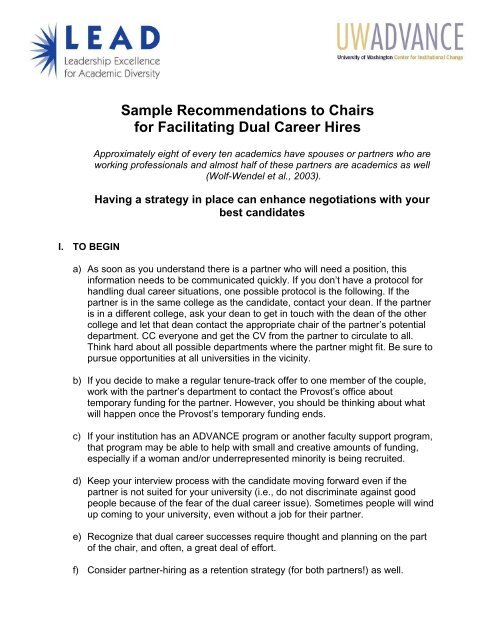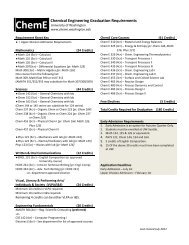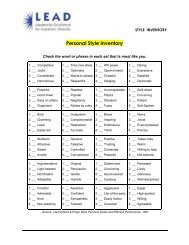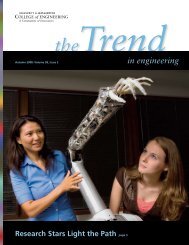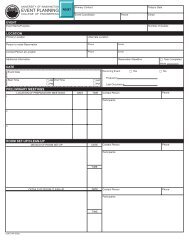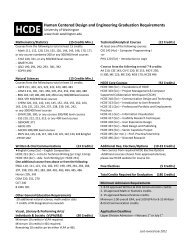Dual Career Tips - University of Washington
Dual Career Tips - University of Washington
Dual Career Tips - University of Washington
You also want an ePaper? Increase the reach of your titles
YUMPU automatically turns print PDFs into web optimized ePapers that Google loves.
Sample Recommendations to Chairs<br />
for Facilitating <strong>Dual</strong> <strong>Career</strong> Hires<br />
Approximately eight <strong>of</strong> every ten academics have spouses or partners who are<br />
working pr<strong>of</strong>essionals and almost half <strong>of</strong> these partners are academics as well<br />
(Wolf-Wendel et al., 2003).<br />
Having a strategy in place can enhance negotiations with your<br />
best candidates<br />
I. TO BEGIN<br />
a) As soon as you understand there is a partner who will need a position, this<br />
information needs to be communicated quickly. If you don’t have a protocol for<br />
handling dual career situations, one possible protocol is the following. If the<br />
partner is in the same college as the candidate, contact your dean. If the partner<br />
is in a different college, ask your dean to get in touch with the dean <strong>of</strong> the other<br />
college and let that dean contact the appropriate chair <strong>of</strong> the partner’s potential<br />
department. CC everyone and get the CV from the partner to circulate to all.<br />
Think hard about all possible departments where the partner might fit. Be sure to<br />
pursue opportunities at all universities in the vicinity.<br />
b) If you decide to make a regular tenure-track <strong>of</strong>fer to one member <strong>of</strong> the couple,<br />
work with the partner’s department to contact the Provost’s <strong>of</strong>fice about<br />
temporary funding for the partner. However, you should be thinking about what<br />
will happen once the Provost’s temporary funding ends.<br />
c) If your institution has an ADVANCE program or another faculty support program,<br />
that program may be able to help with small and creative amounts <strong>of</strong> funding,<br />
especially if a woman and/or underrepresented minority is being recruited.<br />
d) Keep your interview process with the candidate moving forward even if the<br />
partner is not suited for your university (i.e., do not discriminate against good<br />
people because <strong>of</strong> the fear <strong>of</strong> the dual career issue). Sometimes people will wind<br />
up coming to your university, even without a job for their partner.<br />
e) Recognize that dual career successes require thought and planning on the part<br />
<strong>of</strong> the chair, and <strong>of</strong>ten, a great deal <strong>of</strong> effort.<br />
f) Consider partner-hiring as a retention strategy (for both partners!) as well.
II.<br />
ADDITIONAL STRATEGIES<br />
a) Put notice <strong>of</strong> your university’s dual career policy or practices in your job<br />
announcements. Following the <strong>University</strong> <strong>of</strong> California, Irvine, sample wording<br />
would be: “The <strong>University</strong> <strong>of</strong> X is responsive to the needs <strong>of</strong> dual career couples.”<br />
This will encourage your candidates to reveal their dual career status earlier,<br />
rather than later in the interview process, and will give you more time to try to find<br />
a job for the partner.<br />
b) See if your university’s development staff can help with corporate hires.<br />
c) See if your faculty members have contacts for local jobs in industry.<br />
d) It is recommended to use the words “partner hire” vs. “spousal hire” so that all<br />
couples feel more welcome.<br />
III.<br />
IF YOU HIRE THE PARTNER INTO A NON-TENURE TRACK POSITION<br />
a) Make sure that the partner is given an <strong>of</strong>fer in writing. If he/she is also going to<br />
be doing some instruction, it may be worth considering a Without Tenure (WOT)<br />
appointment. Note that research shows that women tend to languish in WOT<br />
positions, and thus departments might consider regularly reviewing and<br />
assessing such positions as a preemptive faculty retention strategy.<br />
b) If the partner is hired as a research pr<strong>of</strong>essor, be sure to set him/her up to<br />
succeed by providing the person with proper lab equipment/space and possibly a<br />
start-up package; helping make contacts with collaborators in the department<br />
and at the university; clearly outlining the position’s promotion and evaluation<br />
expectations; and involving the person fully within the department.<br />
c) Introduce the new research pr<strong>of</strong>essor to the department with as much care as<br />
would be given for a regular tenure-track faculty member. Consider inviting him<br />
or her to give a research seminar to the department to help integrate him or her<br />
into the department, even if the person already gave a seminar as part <strong>of</strong> the<br />
hiring process.<br />
LEAD National Leadership Workshop for SEM Department Chairs<br />
UW ADVANCE Center for Institutional Change<br />
July 21-22, 2008<br />
<strong>University</strong> <strong>of</strong> <strong>Washington</strong>, Seattle


